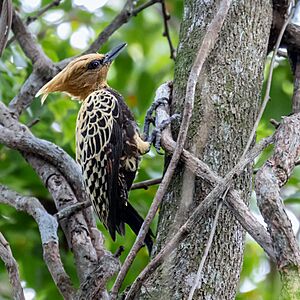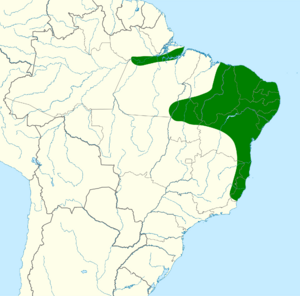Ochre-backed woodpecker facts for kids
Quick facts for kids Ochre-backed woodpecker |
|
|---|---|
 |
|
| female at Arari, Maranhão state, Brazil | |
| Conservation status | |
| Scientific classification | |
| Genus: |
Celeus
|
| Species: |
ochraceus
|
 |
|
| Synonyms | |
|
Celeus flavescens ochraceus |
|
The ochre-backed woodpecker (scientific name: Celeus ochraceus) is a cool type of bird. It belongs to the woodpecker family. This bird lives only in Brazil, which means it's endemic there.
Contents
About the Ochre-backed Woodpecker
For a long time, scientists thought the ochre-backed woodpecker was just a type of blond-crested woodpecker. But in 2011, new studies showed it was different enough to be its own species. This means it's now seen as a full species, not just a subspecies. The ochre-backed woodpecker is also monotypic. This means it does not have any subspecies of its own.
What Does the Ochre-backed Woodpecker Look Like?
This woodpecker is about 25 to 27 centimeters (10 to 11 inches) long. That's about the length of a ruler!
- Males have a wide, dull red area on their cheeks.
- Females have black streaks on their cheeks instead of red.
Both male and female adults have a creamy or yellowish-brown head. This color includes their long, pointed crest, chin, throat, and neck. Their upper body is also yellowish-brown to orange-yellow. It has black markings that can be round or heart-shaped.
Their flight feathers are mostly black. The feathers closer to their body have wide yellowish-brown stripes. The tail feathers are black with light edges or stripes on the outer ones. Their belly area is dark and often has yellowish-brown feather edges. The feathers under their tail have wide, creamy stripes.
Adult woodpeckers have a horn-colored beak. Sometimes it can be blue-gray to blackish, with a lighter lower part. Their eyes are red or reddish-brown. Their legs are blue-gray. Young woodpeckers look similar to adults. However, they are a bit duller and have more brownish-black on their heads.
Where the Ochre-backed Woodpecker Lives
The ochre-backed woodpecker lives in different parts of Brazil. It has a disjunct distribution, meaning its populations are separated.
- One group lives along the south side of the Amazon River. This area stretches from western Pará state to the Atlantic coast.
- Another group lives further south. This area goes from eastern Maranhão state south to Espírito Santo and west to Goiás.
These woodpeckers live inside and at the edges of humid forests. They also live in gallery forest (forests along rivers), savanna, caatinga (a type of dry forest), and fruit orchards.
Ochre-backed Woodpecker Behavior
Movement and Daily Life
The ochre-backed woodpecker stays in the same area all year long. It does not migrate.
What the Ochre-backed Woodpecker Eats
This woodpecker mostly eats insects that live in trees. Its diet includes:
- Tree-dwelling ants
- Carpenter ants
- Termites
It also eats some fruits and berries. The woodpecker usually looks for food in the middle and top parts of the forest. But it can also find food on the ground. It catches insects by picking them off surfaces, poking into holes, pecking, and hammering. It usually feeds in pairs or small groups.
Reproduction and Life Cycle
The ochre-backed woodpecker lays its eggs between April and June. It digs a nest hole in a tree or in a nest made by tree-dwelling ants. Not much else is known about how these woodpeckers raise their young.
Sounds and Calls
The ochre-backed woodpecker makes several different sounds:
- A loud "tsew tsew"
- A "wee-wee-week"
- A series of "wheep" notes
- A harsh "wicka" or "wícket wícket"
It also drums on trees. Its drumming is a soft, steady roll that is repeated at different times.
Conservation Status
The IUCN (International Union for Conservation of Nature) has listed the ochre-backed woodpecker as a species of Least Concern. This means it is not currently in danger of disappearing. It lives across a large area. However, its exact population size is unknown. Scientists believe its numbers might be going down. No immediate threats have been found. It is considered "not uncommon" but is still a "very poorly known woodpecker". More studies and surveys are needed to learn more about it.


